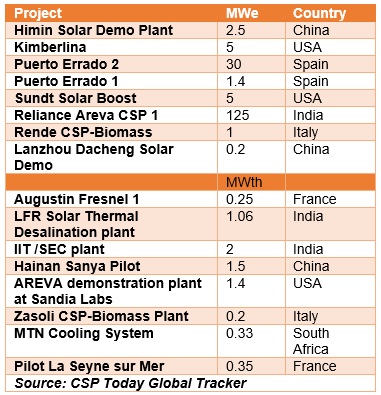Fresnel developer builds India supply base to serve 1.7 GW CSP-coal market
Frenell’s technology will fuel Asia’s first integrated solar thermal power plant and the German developer eyes further cost reductions through supply chain gains, Thomas Mehlitz, Frenell’s project manager for the Dadri project, told New Energy Update.

Related Articles
NTPC’s solar augmentation project is to use Fresnel technology to supply 14 GWh per year into the water-steam cycle of a coal-power unit at the Dadri fossil fuel plant complex. The plant is situated in Uttar Pradesh in north-west India and has a direct normal irradiance of 1169 kWh/m2 per year.
Indian engineering firm Thermax is the EPC provider for the project while Frenell is supplying its Fresnel technology. The Fresnel-based project offered a lower bid price than competing parabolic trough and solar tower projects in a competitive tender held in 2016.
The 15 MWTh CSP plant will be integrated into a wet-cooled 210 MW unit at the Dadri plant complex, which hosts 1.8 GW coal and 817 MW gas-fired capacity. The plant is scheduled for completion by September 2017.
Dadri has suffered from intermittent coal supply shortages which have prevented it from producing its peak load. The CSP plant will raise efficiency and reduce carbon emissions by around 4,060 tons per year, according to a project document published by NTPC in May 2016.
“By using solar heat instead of turbine-extraction steam, the coal-fired station will use less fuel,” Mehlitz told New Energy Update.
Frenell plans to set up solar-field component manufacturing assets and supply chain links in India to increase its competitiveness in future CSP tenders, Mehlitz said.
Thermax estimates some 1.7 GW of solar augmentation projects could be built in India, M.S. Unnikrishnan, CEO of Thermax, said in a statement in November.
NTPC alone has 19 coal-fired power plants in India with an installed capacity of almost 36,000 MW. It also operates eight plants totalling 5,000 MW through joint ventures or subsidiaries.
“Thermax is prepared to continue the lead in offering such integrated solutions,” Unnikrishnan said.
Capex gains
The solar thermal hybrid plant is expected to produce thermal efficiency of 24.4%, compared with 16%-18% for a stand-alone CSP project at the site, according to NTPC documents from May 2016.
Outside the solar field, Hybrid CSP projects share existing balance of system plant infrastructure such as turbine blocks, significantly reducing capital expenditure.
The levelized cost of electricity from hybrid CSP-coal plants can be around 1.8 times lower than that of stand-alone CSP plants, according to a presentation made by Frederic Siros, solar thermal expert at EDF, in 2014.
Capital expenditure can be around half that of stand-alone plants and hybridization makes better use of medium grade heat, the presentation said.
Supply chain
India is already home to the world’s largest Fresnel CSP plant, the 125 MW Areva-Reliance Power in Rajasthan, which has been operating since late 2014.
Operational Fresnel CSP projects

(Data at January 2017)
Fresnel-based solar fields are simpler to deliver than parabolic troughs and solar towers, as they use a simple support structure and widely-available materials.
The primary mirrors are made of flat float-glass mirrors which cost less to manufacture than curved mirrors used in parabolic trough designs, Anton Hoffmann, project engineer at Frenell, told New Energy Update in August 2016.
Frenell has also recently increased heat transfer fluid (HTF) temperatures to up to 550 degrees which “will increase power block efficiency significantly,” he said.
Fresnel is to set up a local fabrication unit in India which will be used to assemble the supporting structure of primary reflector units, Mehlitz told New Energy Update.
“We expect to achieve substantial cost reductions by sourcing materials such as steel and potentially mirrors from the Indian market,” Mehlitz said.
New markets
Integrating CSP into fossil-fuelled power plants could be a viable business case in countries with high fuel prices and high solar irradiation. Industrial applications such as mining sites offer significant market potential.
“Solar augmentation certainly has a large potential around the world. Chile, South Africa, Southwest USA, Morocco, Egypt and Australia all show high potential for integrated solar solutions,” said Mehlitz.
Areva pursued numerous solar-coal boosters in the high-DNI markets of Australia and South Africa before it exited the solar thermal industry.
Coal currently supplies about 77% of South Africa’s energy needs, according to state power utility Eskom. In Australia, coal supplies about 32% of energy needs, data from the country’s Department of Industry shows.
By Heba Hashem
